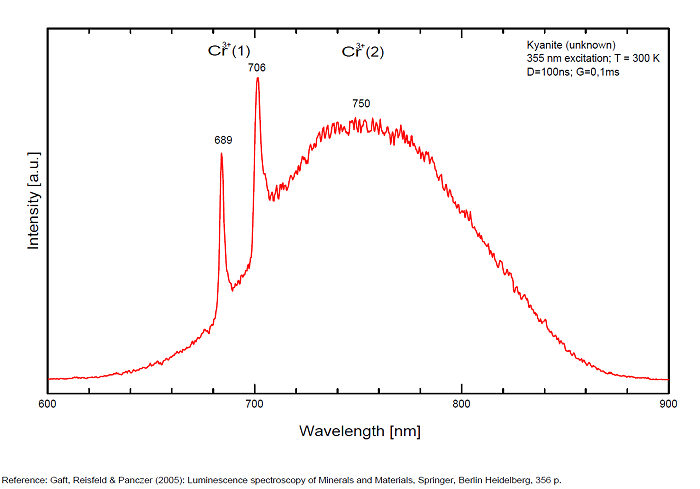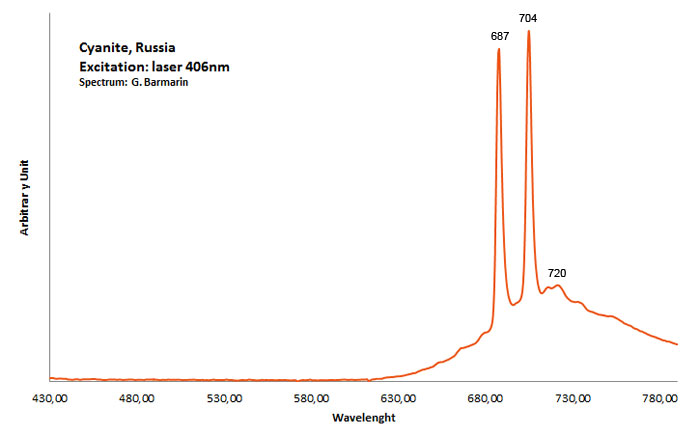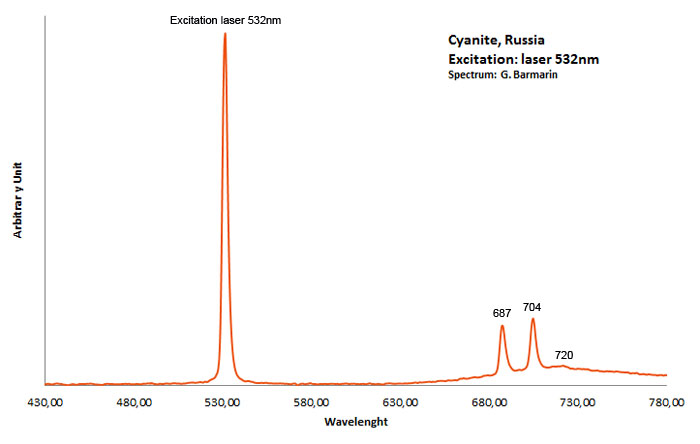Database of luminescent minerals
CYANITE
Chemical formula: Al2SiO5
Family: Silicates
Status: IMA-GP
Crystal system : Triclinic
Display mineral: NON
Associated names (luminescent varieties, discredited names, synonyms, etc.): disthene, kyanite,
Luminescence:
Longwave UV (365nm) colors: |
Red , Yellowish White , Pale Yellow , Orange , Greenish white , Yellowish , | ||
Intensity LW:Very weak | Frequency LW:Often | ||
Midwave UV (320nm) colors: |
Red , Bluish White , Yellowish White , Greenish white , | ||
Intensity MW:Very weak | |||
Shortwave UV (254nm) colors: |
Red , Bluish White , Yellowish White , Greenish white , | ||
Intensity SW:Very weak | |||
Daylight picture

Cyanite (Disthene), Russia.
Col. G. Barmarin; Spectre: G. Barmarin
Longwave (365nm) picture

Pictures Galery:
.jpg)
.jpg)
.jpg)
 ...
...  Go to the galery (13 pictures)
Go to the galery (13 pictures)
Do you have a photo of this mineral you would like to see in the gallery? Contact us!
Phosphorescence (in the common sense of the term) observable with the naked eye:
No phosphorescence visible to the naked eye under any type of UV
Comments:
Kyanite, sillimanite and andalusite are three polymorphs of Al2SiO5.
Activator(s) and spectrum:
Activator(s): Cr3+, TiO6,
Peaks in the spectrum (nm):
Cr3+ replacing Al (site A giving Doublet R-lines) : Lines at 688 or 689 and at 706nm Cr3+ (site B weak crystal field) : broad band peaking at 750nm Cr3+ (site C weak crystal field) : broad band peaking at 780-790nm (Gaft) TiO6 : very large band at 500-570nm (Gorobets)

Spectrum: Michael Gaft, Petah Tikva, Israel. Plot: Institute of Mineralogy, University of Vienna, Austria, with permission of the authors.
Spectrum Galery:



 ...
...Comments on spectrum and activators:
Kyanite has four inequivalent Al3+ sites, which may be substituted by Cr3+. Red luminescence reported to Cr3+ replacing aluminium (Tarashchan in Gaft) but three different site for Cr3+ identified. The study of Cr3+ luminescence in kyanite has long history.
Best localities for fluorescence (*):
- Pfitsch, Tyrol, Austria (colorless cyanite luminescent in red);
- Transvaal, South Africa (red fluorescing);
- Keyvi, Kola peninsula (orange under LW);
- Borisovskie Sopki, Plast, Plastovsky District, Chelyabinsk Oblast, Ural, Russia;
- Kukhi Lal Pamir mountains Tadjikisatsn (yellow-green fluorescence LW);
- Willis Mountains, Dillwyn, Virginia, USA (Gray cyanite fl. bright creamy white SW);
- Khit Ostrov, Northern Karelia, Karelia Republic, Northern Region, Russia ;
- PJ Keating Quarry, Lunenburg, Worcester Co., Massachusetts, USA (deep orange LW);
- Zimbabwe;
(*)The data are not exhaustive and are limited to a few remarkable localities for fluorescence
Bibliographic reference for luminescence:
- The Henkel Glossary of Fluorescent Minerals, Dr. Gerhard Henkel, Published by the FMS, 1989 ,
- Luminescence Spectroscopy of Minerals and Materials, M. Gaft, R. Reisfeld, G. Panczer, Springer Editor, ISBN: 10 3-540-21918-8 ,
- Luminescent Spectra of Minerals, Boris S. Gorobets and Alexandre A. Rogojine, Moscow, 2002 ,
- Handbook of Fluorescent Gems and Minerals, a practical guide for the gem and mineral collector, Jack de Ment, 1949 ,
Reference for luminescence on the Internet:
Mineralogical reference on the Internet:
 http://www.mindat.org/show.php?name=Cyanite
http://www.mindat.org/show.php?name=Cyanite
 http://webmineral.com/data/Cyanite.shtml
http://webmineral.com/data/Cyanite.shtml
Internet Search:
 Image search on 'Google Images'
Image search on 'Google Images'
 Search for documents in all languages on Google
Search for documents in all languages on Google
A request providing no result means only that no such reference exists in the database, but it does not mean that what you are looking for does not exist, just not to our knowledge. If you think you have found an error or omission, please let us know via the contact page being sure to cite the source of information.
